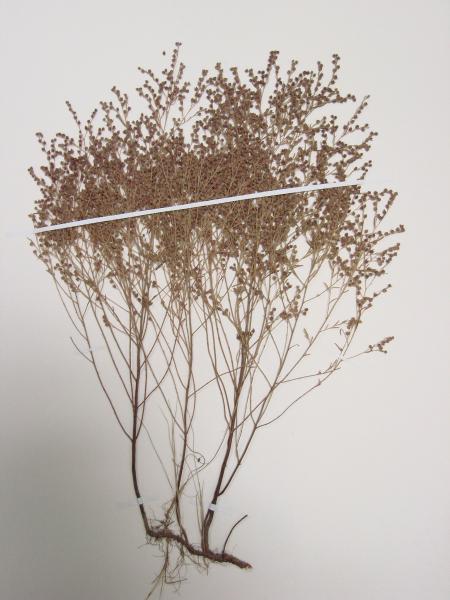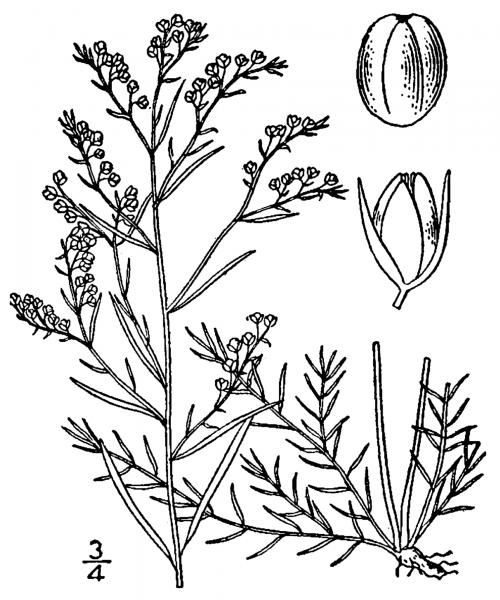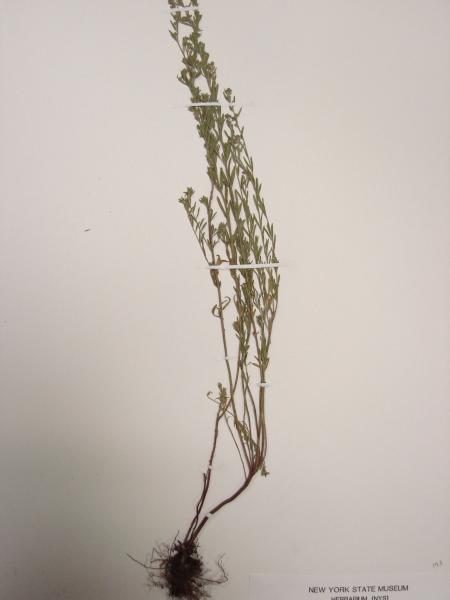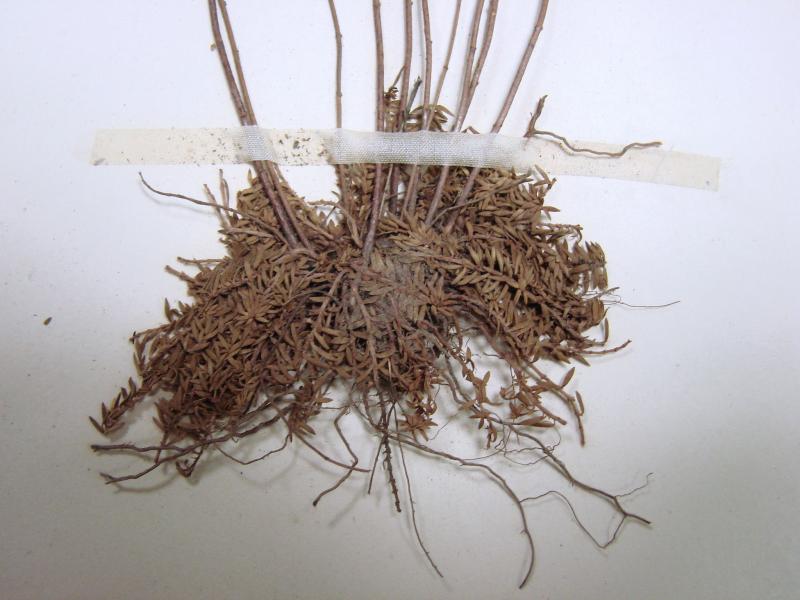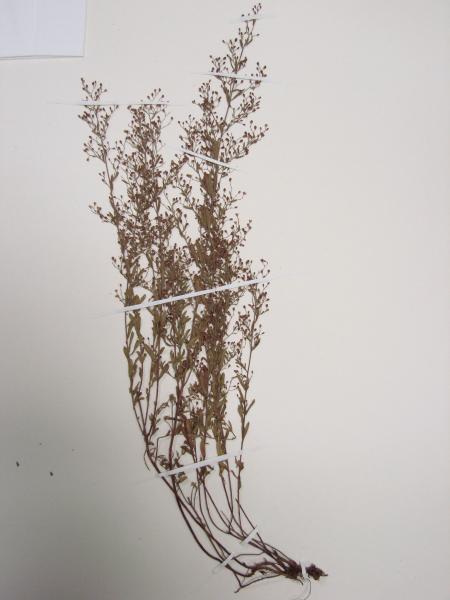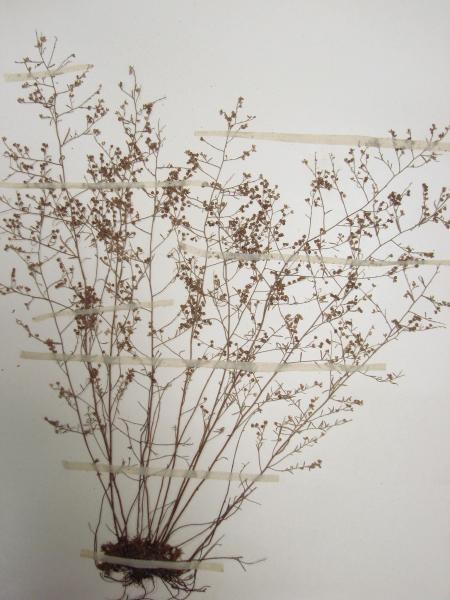Narrow-leaved Pinweed
Lechea tenuifolia Michx.
- Class
- Dicotyledoneae (Dicots)
- Family
- Cistaceae (Rock-Rose Family)
- State Protection
- Threatened
Listed as Threatened by New York State: likely to become Endangered in the foreseeable future. For animals, taking, importation, transportation, or possession is prohibited, except under license or permit. For plants, removal or damage without the consent of the landowner is prohibited.
- Federal Protection
- Not Listed
- State Conservation Status Rank
- S2
Imperiled in New York - Very vulnerable to disappearing from New York due to rarity or other factors; typically 6 to 20 populations or locations in New York, very few individuals, very restricted range, few remaining acres (or miles of stream), and/or steep declines.
- Global Conservation Status Rank
- G5
Secure globally - Common in the world; widespread and abundant (but may be rare in some parts of its range).
Summary
Did you know?
The genus Lechea was named by Linneaus for Johan Leche (1704-1764), a Swedish botanist who taught in Finland. He is regarded as the father of meteorology and space research in Finland for his early measurements of air temperature (at the suggestion of Anders Celsius) and documentation of the northern lights. So the next time you are looking at Lechea on a hot day think of Dr. Leche. The species name refers to the very long narrow leaves of the basal shoot.
State Ranking Justification
There are 18 existing populations but only four of these are in good condition with substantial numbers for good viability. Five populations need to be resurveyed to obtain more information about condition and numbers. There are seven historical occurrences.
Short-term Trends
Existing populations seem stable although more survey work needs to be done to assess more populations since many plants occur in human-disturbed areas that could change quickly.
Long-term Trends
This species was never common in New York and is restricted mainly to eastern Long Island with a few disjunct populations in the Hudson Valley. Many historical populations have been relocated and there are now more existing populations than remaining historical records. Over the last 100 years the number of populations has probably remained about the same even though the size of the populations may have decreased.
Conservation and Management
Threats
The open habitat, often along roadsides and trails, is threatened by improper maintenance that destroys plants during the growing season or by direct impact from vehicles and ATVs. Hikers do not seem to affect the plants as much as vehicles. Conversely, if the habitat is not kept open the plants are threatened by succession.
Conservation Strategies and Management Practices
Prevent direct damage from vehicles and ATVs. Keep the habitat open by mowing but refrain from destroying plants before they flower and fruit.
Habitat
Habitat
In New York Slender Pinweed occurs in dry, often grassy, natural or artificial open habitats. These include pine or oak barrens, and disturbances within them such such as roads, firebreaks, ATV trails, or runways, as well as rocky slopes and summits on limestone. (New York Natural Heritage Program 2007). Dry sandy or rocky open woods and slopes (Fernald 1970). Dry soil, upland woods and barrens (Gleason 1952).
Associated Ecological Communities
- Coastal oak-hickory forest
(guide)
A hardwood forest with oaks and hickories codominant that occurs in dry, well-drained, loamy sand of knolls, upper slopes, or south-facing slopes of glacial moraines of the Atlantic Coastal Plain.
- Mowed roadside/pathway
A narrow strip of mowed vegetation along the side of a road, or a mowed pathway through taller vegetation (e.g., meadows, old fields, woodlands, forests), or along utility right-of-way corridors (e.g., power lines, telephone lines, gas pipelines). The vegetation in these mowed strips and paths may be dominated by grasses, sedges, and rushes; or it may be dominated by forbs, vines, and low shrubs that can tolerate infrequent mowing.
- Pitch pine-scrub oak barrens
(guide)
A shrub-savanna community that occurs on well-drained, sandy soils that have developed on sand dunes, glacial till, and outwash plains.
- Red cedar rocky summit
(guide)
A community that occurs on warm, dry, rocky ridgetops and summits where the bedrock is calcareous (such as limestone or dolomite, but also marble, amphibolite, and calcsilicate rock), and the soils are more or less calcareous. The vegetation may be sparse or patchy, with numerous lichen covered rock outcrops.
- Successional old field*
A meadow dominated by forbs and grasses that occurs on sites that have been cleared and plowed (for farming or development), and then abandoned or only occasionally mowed.
* probable association but not confirmed.
Associated Species
- Andropogon virginicus
- Boechera laevigata
- Cardamine parviflora (small-flowered bitter cress)
- Carex pensylvanica (Pennsylvania sedge)
- Carya ovata
- Comptonia peregrina (sweet-fern)
- Danthonia compressa (northern oat grass)
- Deschampsia flexuosa
- Eupatorium album
- Euthamia graminifolia (common flat-topped-goldenrod)
- Hypericum gentianoides (orange-grass)
- Ionactis linariifolius
- Juniperus virginiana
- Lechea minor (thyme-leaved pinweed)
- Lechea racemulosa (oblong-fruited pinweed)
- Lespedeza
- Ostrya virginiana (hop hornbeam, ironwood)
- Paronychia canadensis (smooth forked-chickweed)
- Pinus rigida (pitch pine)
- Polygala nuttallii (Nuttall's milkwort)
- Polygonum tenue (pleated-leaved knotweed)
- Potentilla canadensis (dwarf cinquefoil)
- Quercus ilicifolia (scrub oak, bear oak)
- Quercus rubra (northern red oak)
- Rubus flagellaris (northern dewberry)
- Schizachyrium scoparium
- Trichostema
Range
New York State Distribution
In New York Lechea tenuifolia is found on Long Island and in the lower Hudson Valley as far north as Orange County.
Global Distribution
Slender Pinweed reaches the northeastern limit of its range in northern New England, and is known from all states east of the Mississippi, except Michigan, and west from Minnesota to Texas. In Canada it is known only from Manitoba.
Identification Comments
General Description
Slender Pinweed is a perennial herb, the stem with ascending hairs and up to 30 cm tall. It has small (< 2 cm long) linear leaves usually at least 10 times as long as wide. Late in the growing season the plant produces basal shoots with many, crowded, tiny (3-6 mm long) leaves. The flowers are in a large, branched infloresence (a panicle). They have 5 sepals, the 2 outer ones are linear and exceed the 3 inner ones as well as the 3 red petals (and later, the 3-parted, dry fruit). The flowers rarely open (Voss 1985).
Best Life Stage for Proper Identification
This species is best identified late in the growing season when the leafy basal shoots and ripened fruit are present.
Similar Species
The genus, when flowers are present, is distinctive. Lechea mucronata has keeled sepals, and the leaves of the basal shoots are larger (to 15 mm) and elliptic. L. racemulosa and L. minor both have stem leaves less than 10 times as long as wide (Gleason and Cronquist 1991).
Best Time to See
Slender pinweed begins flowering in August and fruit may be present from August into November.
- Flowering
- Fruiting
The time of year you would expect to find Narrow-leaved Pinweed flowering and fruiting in New York.
Narrow-leaved Pinweed Images
Taxonomy
Narrow-leaved Pinweed
Lechea tenuifolia Michx.
- Kingdom Plantae
- Phylum Anthophyta
- Class Dicotyledoneae
(Dicots)
- Order Violales
- Family Cistaceae (Rock-Rose Family)
- Order Violales
- Class Dicotyledoneae
(Dicots)
- Phylum Anthophyta
Additional Common Names
- Slender Pinweed
Additional Resources
Best Identification Reference
Gleason, Henry A. and A. Cronquist. 1991. Manual of Vascular Plants of Northeastern United States and Adjacent Canada. The New York Botanical Garden, Bronx, New York. 910 pp.
Other References
Barringer, Kerry. 2004. New Jersey Pinweeds (Lechea, Cistaceae). Journal of the Torrey Botanical Society 131(3), 2004, pp. 261-276.
Clemants, Steven and Carol Gracie. 2006. Wildflowers in the Field and Forest. A Field Guide to the Northeastern United States. Oxford University Press, New York, NY. 445 pp.
Fernald, M.L. 1950. Gray's manual of botany. 8th edition. D. Van Nostrand, New York. 1632 pp.
Haines, Arthur and Thomas F. Vining. 1998. Flora of Maine. A Manual for Identification of Native and Naturalized Vascular Plants of Maine.
Holmgren, Noel. 1998. The Illustrated Companion to Gleason and Cronquist's Manual. Illustrations of the Vascular Plants of Northeastern United States and Adjacent Canada. The New York Botanical Garden, Bronx, New York.
New York Natural Heritage Program. 2010. Biotics database. New York Natural Heritage Program. New York State Department of Environmental Conservation. Albany, NY.
New York Natural Heritage Program. 2024. New York Natural Heritage Program Databases. Albany, NY.
Newcomb, Lawrence. 1977. Newcomb's Wildflower Guide: An Ingenious New Key System for Quick, Positive Field Identification of the Wildflowers, Flowering Shrubs, and Vines of Northeastern and North-Central North America. Little, Brown and Company. Boston.
Voss, E.G. 1985. Michigan Flora. Part II. Dicots (Saururaceae - Cornaceae). Cranbrook Institute of Science and University of Michigan Herbarium. Ann Arbor, Michigan. 724 pp.
Voss, E.G. 1985. Michigan flora. Part II. Dicotyledons. Cranbrook Institute of Science and University of Michigan Herbarium. Ann Arbor, Michigan. 1212 pp.
Weldy, T. and D. Werier. 2010. New York flora atlas. [S.M. Landry, K.N. Campbell, and L.D. Mabe (original application development), Florida Center for Community Design and Research http://www.fccdr.usf.edu/. University of South Florida http://www.usf.edu/]. New York Flora Association http://newyork.plantatlas.usf.edu/, Albany, New York
Weldy, Troy W. and David Werier. 2005. New York Flora Atlas. [S.M. Landry, K.N. Campbell, and L.D. Mabe (original application development), Florida Center for Community Design and Research. University of South Florida]. New York Flora Association, Albany, NY. Available on the web at (http://newyork.plantatlas.usf.edu/).
Links
About This Guide
Information for this guide was last updated on: December 11, 2008
Please cite this page as:
New York Natural Heritage Program. 2024.
Online Conservation Guide for
Lechea tenuifolia.
Available from: https://guides.nynhp.org/slender-pinweed/.
Accessed July 27, 2024.
